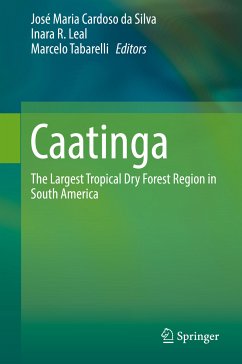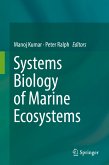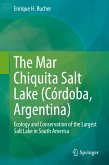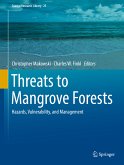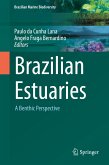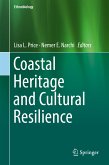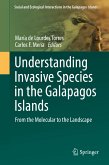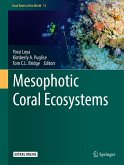Caatinga (eBook, PDF)
The Largest Tropical Dry Forest Region in South America
Redaktion: Silva, José Maria Cardoso Da; Tabarelli, Marcelo; Leal, Inara R.
160,95 €
160,95 €
inkl. MwSt.
Sofort per Download lieferbar

80 °P sammeln
160,95 €
Als Download kaufen

160,95 €
inkl. MwSt.
Sofort per Download lieferbar

80 °P sammeln
Jetzt verschenken
Alle Infos zum eBook verschenken
160,95 €
inkl. MwSt.
Sofort per Download lieferbar
Alle Infos zum eBook verschenken

80 °P sammeln
Caatinga (eBook, PDF)
The Largest Tropical Dry Forest Region in South America
Redaktion: Silva, José Maria Cardoso Da; Tabarelli, Marcelo; Leal, Inara R.
- Format: PDF
- Merkliste
- Auf die Merkliste
- Bewerten Bewerten
- Teilen
- Produkt teilen
- Produkterinnerung
- Produkterinnerung

Bitte loggen Sie sich zunächst in Ihr Kundenkonto ein oder registrieren Sie sich bei
bücher.de, um das eBook-Abo tolino select nutzen zu können.
Hier können Sie sich einloggen
Hier können Sie sich einloggen
Sie sind bereits eingeloggt. Klicken Sie auf 2. tolino select Abo, um fortzufahren.

Bitte loggen Sie sich zunächst in Ihr Kundenkonto ein oder registrieren Sie sich bei bücher.de, um das eBook-Abo tolino select nutzen zu können.
The first English-language book focused exclusively on South America's largest tropical dry forest
One of the few books on regional sustainable development that examines an entire, large ecological (rather than political) tropical region
One of the few books on regional sustainable development that proposes a roadmap for the conservation of natural resources and human development by synthesizing information on biodiversity, key ecosystem services and socio-economic systems
- Geräte: PC
- ohne Kopierschutz
- eBook Hilfe
- Größe: 16MB
Andere Kunden interessierten sich auch für
![Systems Biology of Marine Ecosystems (eBook, PDF) Systems Biology of Marine Ecosystems (eBook, PDF)]() Systems Biology of Marine Ecosystems (eBook, PDF)136,95 €
Systems Biology of Marine Ecosystems (eBook, PDF)136,95 €![The Mar Chiquita Salt Lake (Córdoba, Argentina) (eBook, PDF) The Mar Chiquita Salt Lake (Córdoba, Argentina) (eBook, PDF)]() Enrique H. BucherThe Mar Chiquita Salt Lake (Córdoba, Argentina) (eBook, PDF)72,95 €
Enrique H. BucherThe Mar Chiquita Salt Lake (Córdoba, Argentina) (eBook, PDF)72,95 €![Threats to Mangrove Forests (eBook, PDF) Threats to Mangrove Forests (eBook, PDF)]() Threats to Mangrove Forests (eBook, PDF)136,95 €
Threats to Mangrove Forests (eBook, PDF)136,95 €![Brazilian Estuaries (eBook, PDF) Brazilian Estuaries (eBook, PDF)]() Brazilian Estuaries (eBook, PDF)72,95 €
Brazilian Estuaries (eBook, PDF)72,95 €![Coastal Heritage and Cultural Resilience (eBook, PDF) Coastal Heritage and Cultural Resilience (eBook, PDF)]() Coastal Heritage and Cultural Resilience (eBook, PDF)112,95 €
Coastal Heritage and Cultural Resilience (eBook, PDF)112,95 €![Understanding Invasive Species in the Galapagos Islands (eBook, PDF) Understanding Invasive Species in the Galapagos Islands (eBook, PDF)]() Understanding Invasive Species in the Galapagos Islands (eBook, PDF)72,95 €
Understanding Invasive Species in the Galapagos Islands (eBook, PDF)72,95 €![Mesophotic Coral Ecosystems (eBook, PDF) Mesophotic Coral Ecosystems (eBook, PDF)]() Mesophotic Coral Ecosystems (eBook, PDF)272,95 €
Mesophotic Coral Ecosystems (eBook, PDF)272,95 €-
-
-
The first English-language book focused exclusively on South America's largest tropical dry forest
One of the few books on regional sustainable development that examines an entire, large ecological (rather than political) tropical region
One of the few books on regional sustainable development that proposes a roadmap for the conservation of natural resources and human development by synthesizing information on biodiversity, key ecosystem services and socio-economic systems
One of the few books on regional sustainable development that examines an entire, large ecological (rather than political) tropical region
One of the few books on regional sustainable development that proposes a roadmap for the conservation of natural resources and human development by synthesizing information on biodiversity, key ecosystem services and socio-economic systems
Dieser Download kann aus rechtlichen Gründen nur mit Rechnungsadresse in A, B, BG, CY, CZ, D, DK, EW, E, FIN, F, GR, HR, H, IRL, I, LT, L, LR, M, NL, PL, P, R, S, SLO, SK ausgeliefert werden.
Produktdetails
- Produktdetails
- Verlag: Springer International Publishing
- Seitenzahl: 482
- Erscheinungstermin: 9. Januar 2018
- Englisch
- ISBN-13: 9783319683393
- Artikelnr.: 53062195
- Verlag: Springer International Publishing
- Seitenzahl: 482
- Erscheinungstermin: 9. Januar 2018
- Englisch
- ISBN-13: 9783319683393
- Artikelnr.: 53062195
- Herstellerkennzeichnung Die Herstellerinformationen sind derzeit nicht verfügbar.
José Maria Cardoso da Silva has a BSc. from Universidade Federal do Pará, MSc. from Universidade de Brasília and a PhD from the University of Copenhagen. He is currently Professor of the Department of Geography at the University of Miami. He has more than 15 years managing conservation programs and developing research on sustainable development around the world. Dr. Silva has published more than 100 papers and book chapters. He received several awards for his scientific accomplishments. Inara R. Leal has the BSc from Universidade Federal de Santa Catarina and a PhD from Universidade Estadual de Campinas. She is Adjunct Professor at the Universidade Federal de Pernambuco. Her research is focused on how anthropogenic disturbances influence plant-animal interactions in Caatinga and Atlantic Forest. Dr. Leal has published more than a 100 papers and book chapters, and 6 books. Marcelo Tabarelli has a BSc in Agronomic Engineering fromUniversidade Federal de Santa Maria and a PhD from Universidade de São Paulo. Currently, he is Associate Professor at Universidade Federal de Pernambuco with research activities devoted to plant ecology and conservation, particularly tropical forests. Dr. Tabarelli has published over 100 papers and dozens of book chapters.
Part I Introduction: Chapter 1: The Caatinga: understanding the challenges.- Part II Biodiversity: Chapter 2: Diversity and evolution of the flowering plants of the Caatinga Domain.- Chapter 3: Ants of the Caatinga: diversity, biogeography and functional responses to anthropogenic disturbance and climate change.- Chapter 4: Diversity, distribution and conservation of the Caatinga fishes: advances and challenges.- Chapter 5: Ecology, biogeography and conservation of amphibians of the Caatinga.- Chapter 6: Species composition, biogeography and conservation of the Caatinga Lizards.- Chapter 7: The avifauna of the Caatinga: biogeography, ecology, and conservation.- Chapter 8: Mammals of the Caatinga: diversity, ecology, biogeography and conservation.- Chapter 9: Plant-animal interactions in the Caatinga: overview and perspectives.- Part III Ecosystem Services: Chapter 10: Water as capital and its uses in the Caatinga.- Chapter 11: People and natural resources in the Caatinga.-Chapter 12: Cultural Services in the Caatinga.- Part IV Threats: Chapter 13: Human impacts on the Caatinga.- Chapter 14: The socioecology of the Caatinga: understanding how natural resource use shapes an ecosystem.- Chapter 15: Future climate change in the Caatinga.- Part V Solutions: Chapter 16: Sustainable agricultural uses in the Caatinga.- Chapter 17: Conservation opportunities in the Caatinga.- Chapter 18: Sustainable development in the Caatinga.- Part VI Conclusions: Chapter 19: The future of the Caatinga.-
Part I Introduction: Chapter 1: The Caatinga: understanding the challenges.- Part II Biodiversity: Chapter 2: Diversity and evolution of the flowering plants of the Caatinga Domain.- Chapter 3: Ants of the Caatinga: diversity, biogeography and functional responses to anthropogenic disturbance and climate change.- Chapter 4: Diversity, distribution and conservation of the Caatinga fishes: advances and challenges.- Chapter 5: Ecology, biogeography and conservation of amphibians of the Caatinga.- Chapter 6: Species composition, biogeography and conservation of the Caatinga Lizards.- Chapter 7: The avifauna of the Caatinga: biogeography, ecology, and conservation.- Chapter 8: Mammals of the Caatinga: diversity, ecology, biogeography and conservation.- Chapter 9: Plant-animal interactions in the Caatinga: overview and perspectives.- Part III Ecosystem Services: Chapter 10: Water as capital and its uses in the Caatinga.- Chapter 11: People and natural resources in the Caatinga.-Chapter 12: Cultural Services in the Caatinga.- Part IV Threats: Chapter 13: Human impacts on the Caatinga.- Chapter 14: The socioecology of the Caatinga: understanding how natural resource use shapes an ecosystem.- Chapter 15: Future climate change in the Caatinga.- Part V Solutions: Chapter 16: Sustainable agricultural uses in the Caatinga.- Chapter 17: Conservation opportunities in the Caatinga.- Chapter 18: Sustainable development in the Caatinga.- Part VI Conclusions: Chapter 19: The future of the Caatinga.-
